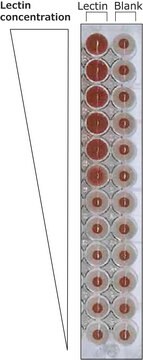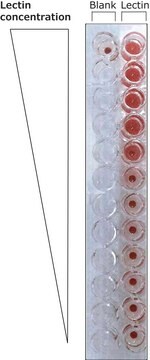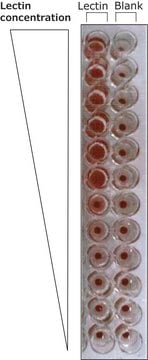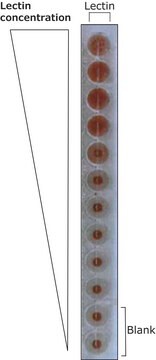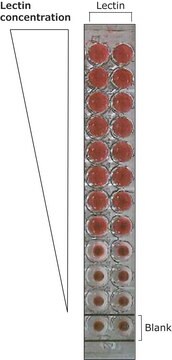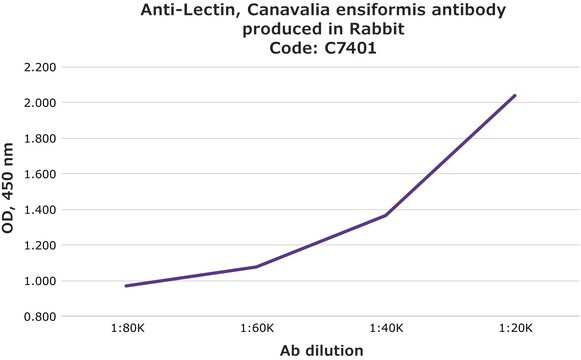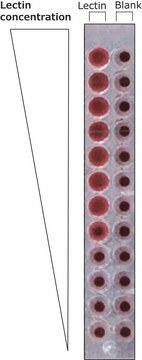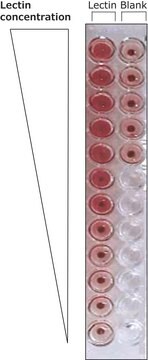T4144
Anti-Lectin, Triticum vulgaris antibody produced in rabbit
fractionated antiserum, lyophilized powder
Synonim(y):
Anti-WGA, Anti-Wheat germ lectin
Zaloguj sięWyświetlanie cen organizacyjnych i kontraktowych
About This Item
Polecane produkty
pochodzenie biologiczne
rabbit
Poziom jakości
białko sprzężone
unconjugated
forma przeciwciała
fractionated antiserum
rodzaj przeciwciała
primary antibodies
klon
polyclonal
Formularz
lyophilized powder
reaktywność gatunkowa
Triticum vulgaris
opakowanie
vial of 2 mL
metody
indirect ELISA: 1:50,000
temp. przechowywania
2-8°C
docelowa modyfikacja potranslacyjna
unmodified
Opis ogólny
Wheat germ lectin, also known as wheat germ agglutinin (WGA), has a molecular weight of 36 kDa. It shows affinity to 1,4-N-acetylglucosamine (GlcNAc) oligomers and is useful in studying surface components of C. neoformans.
Immunogen
Wheat Germ lectin (WGA)
Zastosowanie
Anti-Lectin, Triticum vulgaris antibody produced in rabbit has been used in
- immunolabeling experiments
- immunohistochemistry
- immunocytochemistry
Anti-Lectin, Triticum vulgaris antibody produced in rabbit has been used in immunohistochemistry and immunocytochemistry.
Działania biochem./fizjol.
Wheat germ agglutinin is a lectin isolated from Triticum vulgaris that has affinity for chitin oligosaccharides, peptidoglycans and glycolipids via sialic acid residues. It is not specific for human blood groups and has been identified as antagonists of botulinum and tetanus toxins.
Opis wartości docelowych
Lectins are highly specific carbohydrate binding proteins useful in carbohydrate and cell membrane studies, as well as cell agglutination and typing techniques.
Postać fizyczna
Lyophilized from 0.01 M phosphate buffered saline, pH 7.2
Rekonstytucja
Reconstitute with 2 ml deionized water.
Oświadczenie o zrzeczeniu się odpowiedzialności
Unless otherwise stated in our catalog or other company documentation accompanying the product(s), our products are intended for research use only and are not to be used for any other purpose, which includes but is not limited to, unauthorized commercial uses, in vitro diagnostic uses, ex vivo or in vivo therapeutic uses or any type of consumption or application to humans or animals.
Ta strona może zawierać tekst przetłumaczony maszynowo.
Nie możesz znaleźć właściwego produktu?
Wypróbuj nasz Narzędzie selektora produktów.
Kod klasy składowania
12 - Non Combustible Liquids
Klasa zagrożenia wodnego (WGK)
WGK 3
Temperatura zapłonu (°F)
Not applicable
Temperatura zapłonu (°C)
Not applicable
Środki ochrony indywidualnej
Eyeshields, Gloves, type N95 (US)
Wybierz jedną z najnowszych wersji:
Masz już ten produkt?
Dokumenty związane z niedawno zakupionymi produktami zostały zamieszczone w Bibliotece dokumentów.
João Manuel Braz et al.
The Journal of comparative neurology, 507(6), 1990-2003 (2008-02-15)
Despite the evidence for a significant contribution of brainstem serotonergic (5HT) systems to the control of spinal cord "pain" transmission neurons, attention has turned recently to the influence of nonserotonergic neurons, including the facilitatory and inhibitory controls that originate from
Detection of local and remote cellular damage caused by spinal cord and peripheral nerve injury using a heat shock signaling reporter system
Hashimoto-Torii K, et al.
IBRO reports, 91-98 (2018)
N Bakry et al.
The Journal of pharmacology and experimental therapeutics, 258(3), 830-836 (1991-09-01)
Lectins from Anguilla anguilla, Artocarpus integrifolia, Canavalia ensiformis, Datora stramonium, Glycine max, Limax flavus, Ricinus communis and Triticum vulgaris were tested for their abilities to antagonize the binding of botulinum neurotoxin and tetanus toxin to rat brain membranes and to
Amygdala projections to the lateral bed nucleus of the stria terminalis in the macaque: comparison with ventral striatal afferents
decamp DM and Fudge JL
The Journal of Comparative Neurology, 521, 3191-3216 (2013)
Detection of local and remote cellular damage caused by spinal cord and peripheral nerve injury using a heat shock signaling reporter system
Hashimoto-Torii K, et al.
IBRO reports, 5, 91-98 (2018)
Nasz zespół naukowców ma doświadczenie we wszystkich obszarach badań, w tym w naukach przyrodniczych, materiałoznawstwie, syntezie chemicznej, chromatografii, analityce i wielu innych dziedzinach.
Skontaktuj się z zespołem ds. pomocy technicznej